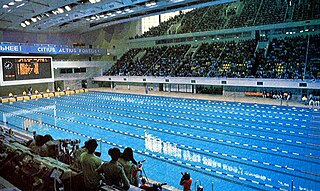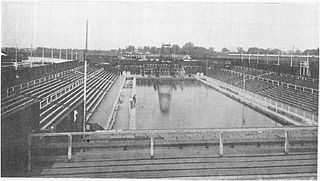At the 1904 Summer Olympics, nine swimming events were contested. The 1904 swimming competition was the only time in Olympic history that racing distances were measured in yards. The competition was held September 4–6, 1904. There was a total of 32 participants from 5 countries competing.

Swimming has been a sport at every modern Summer Olympics. It has been open to women since 1912. At the Olympics, swimming has the second-highest number of medal-contested events.

The men's 200 metre freestyle was a sprint swimming event in the Swimming at the 1900 Summer Olympics program in Paris. It was the shortest of the three freestyle events. It was held on 11 August and 12 August 1900. 26 swimmers from 10 nations competed. The event was won by Frederick Lane of Australia, with Zoltán Halmay of Hungary earning silver and Karl Ruberl of Austria earning bronze.

The men's 100 metre freestyle was one of six swimming events on the swimming at the 1908 Summer Olympics programme. It was the shortest of the three individual freestyle events, as the 50 yard freestyle had been dropped after its one appearance on the 1904 Summer Olympics programme. The 100 metre event was contested for the third time after it had been held at the 1896 and 1906 Olympics. The 1904 Olympics saw a 100-yard event. The competition was held on Friday 17 July 1908 and Monday 20 July 1908. Thirty-four swimmers from twelve nations competed. Each nation was limited to 12 swimmers.
The men's 400 metre freestyle was one of six swimming events on the swimming at the 1908 Summer Olympics programme. Its distance was the median of the 3 individual freestyle event distances. It was the first time an event over 400 metres was held at the Olympics. The competition was held from Monday July 13, 1908 to Thursday July 16, 1908.

Otto Wahle was an Austrian-American swimmer who took part in two Summer Olympic Games and won a total of three medals. Wahle coached the men's US swim team at the 1912 Olympics, and the men's US water polo team at the 1920 and 1924 Olympics.
The men's 50 yard freestyle was a swimming event held as part of the Swimming at the 1904 Summer Olympics programme. It was the first time the short-distance event was held at the Olympics, and the only time the distance of 50 yards was used. Subsequent editions of the programme would use a distance of 50 metres, though the short sprint would not reappear until the 1988 Summer Olympics.

The men's 100 yard freestyle was a swimming event held as part of the Swimming at the 1904 Summer Olympics programme. It was the second time the event was held at the Olympics, though the only time yards were used instead of metres. 9 swimmers from 2 nations competed. The event was won by Zoltán Halmay of Hungary, the nation's second consecutive victory in the 100 yard/metre freestyle.

The men's 220 yard freestyle was a swimming event held as part of the Swimming at the 1904 Summer Olympics programme. It was the second time the event was held at the Olympics, though the only time yards were used instead of metres. The length of 220 yards was slightly longer than the 200 metres that had been held at the 1900 Summer Olympics and that would return at the 1968 Summer Olympics. It was held on 6 September in a man-made lake in Forest Park. 4 swimmers from 3 nations competed. The event was won by Charles Daniels of the United States. Francis Gailey of Australia took silver, while Emil Rausch of Germany earned bronze. It was the first medal in the 200 metre/220 yard freestyle for each of the United States and Germany; Australia had received gold in 1900.
The men's 880 yard freestyle was a swimming event held as part of the Swimming at the 1904 Summer Olympics programme. The length of 880 yards was slightly longer than the 800 metres. It was the only time the event was held at the Olympics; the men's 800 metre freestyle event was introduced 116 years later, at the 2020 Summer Olympics.
The men's 440 yard breaststroke was a swimming event held as part of the Swimming at the 1904 Summer Olympics programme. It was the first time any breaststroke event was held at the Olympics. Two later editions of the swimming programme used the 400 metre breaststroke, but the shorter 200 and 100 metre races became more common.
The men's 4 × 50 yard freestyle relay was a swimming event held as part of the Swimming at the 1904 Summer Olympics programme. It was the first time any relay event was held at the Olympics. It was the only time yards were used instead of metres, and the only time the 50 was used as a distance rather than the 100 or 200 metre legs that were common.
Francis "Frank" Gailey was an Australian-born American competition swimmer who swam in the 1904 Summer Olympics held in St. Louis, Missouri.
Georg Hoffmann (1880–1947) was a German freestyle, backstroke, breaststroke swimmer and diver who competed in the 1904 Summer Olympics and 1906 Intercalated Games.

The men's 200 metre freestyle event at the 1980 Summer Olympics was held on 21 July at the Swimming Pool at the Olimpiysky Sports Complex. There were 42 competitors from 24 nations, with each nation having up to three swimmers. The event was won by Sergey Koplyakov of the Soviet Union, with his countryman Andrey Krylov finishing second. The medals were the first for the Soviet Union in the men's 200 metre freestyle. Graeme Brewer of Australia won that nation's first medal in the event since 1968 with his bronze.

The men's 100 metre freestyle was a swimming event held as part of the swimming at the 1920 Summer Olympics programme. It was the fourth appearance of the event. A total of 31 swimmers from 15 nations competed in the event, which was held from August 22 to August 29, 1920. Nations were limited to four swimmers each. The United States swept the medals, and Duke Kahanamoku broke his own Olympic record in the semifinals and bettered his time again in the final to successfully defend his championship from 1912. Kahanamoku was the first man to successfully defend an Olympic 100 metres freestyle title and third man to win multiple medals of any color in the event.
The men's 100 metre freestyle was a swimming event held as part of the swimming at the 1924 Summer Olympics programme. It was the sixth appearance of the event, which had not been featured at the 1900 Games. The competition was held on Saturday July 19, 1924 and on Sunday July 20, 1924. There were 30 competitors from 15 nations. Nations were limited to three swimmers each, down from four in 1920. The United States swept the medals for the second consecutive Games, winning its fourth consecutive gold medal. Johnny Weissmuller beat two-time defending champion Duke Kahanamoku in the final. Kahanamoku was the first man to win three medals in the event. His brother Samuel Kahanamoku earned the bronze medal.

The men's 100 metre freestyle was a swimming event held as part of the swimming at the 1928 Summer Olympics programme. It was the seventh appearance of the event, which had not been featured only at the 1900 Games. The competition was held on Friday and Saturday, 10 and 11 August 1928. Thirty swimmers from 17 nations competed. Nations had been limited to three swimmers each since the 1924 Games. Johnny Weissmuller of the United States repeated as gold medalist in the event, the second man to do so. It was the fifth consecutive victory for an American swimmer in the men's 100 metre freestyle. István Bárány earned Hungary's first medal in the event since 1908 with his silver. Katsuo Takaishi's bronze was Japan's first men's 100 metre freestyle medal. Bárány and Takaishi prevented the Americans from sweeping the medals a third consecutive time, as the United States swimmers finished first, fourth, and fifth.

The men's 100 metre freestyle was a swimming event held as part of the swimming at the 1936 Summer Olympics programme. It was the ninth appearance of the event, which had not been featured only at the 1900 Games. The competition was held on Saturday and Sunday, 8 and 9 August 1936. Forty-five swimmers from 23 nations competed. Nations had been limited to three swimmers each since the 1924 Games. The event was won by Ferenc Csik of Hungary, the nation's first victory in the event since 1904 and third overall. For the second consecutive Games, Japan took two medals in the 100 metre freestyle, this time silver and bronze. The United States' seven-Games medal streak in the event ended as the nation's best result was sixth place by Peter Fick.

The men's 200 metre freestyle event at the 1968 Olympic Games took place on 24 October at the Alberca Olímpica Francisco Márquez. It was the third time the event was held, returning for the first time since 1904. There were 57 competitors from 26 nations, with each nation having up to three swimmers. The event was won by Michael Wenden of Australia, the nation's second victory in the event ; Australia extended its podium streak in the event to three Games over 68 years. It was Wenden's second gold medal of the Games, completing a 100/200 free double. Americans Don Schollander and John Nelson took silver and bronze, respectively.











